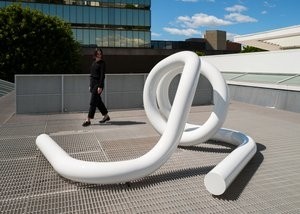
Carol Bove: Mary
A special installation of Carol Bove’s sculpture Mary (2025) is on view on the roof of Gagosian, Beverly Hills, for two weeks only. The work belongs to the artist’s celebrated Glyph series, a succession of glossy, white-painted, looping cylindrical tubes of stainless steel.
Mary and related works such as Celeste (2013) and Mood (2017) employ bold large-scale forms to intentionally evoke the monumental pseudo-modernist structures frequently commissioned for public and corporate spaces worldwide and sometimes derided as “plaza art.” The lime green curvilinear benches installed by landscape architect Martha Schwartz in New York’s Federal Plaza in 1997 after the removal of Richard Serra’s Tilted Arc (1981) are a canonical example. Far from embracing or responding directly to the austere look of the surrounding architecture, they instead attempt to soften it with a panacea.
In engaging the look and feel of such projects in her own sculptures, and by titling them Glyphs, an abstract symbol for nonverbal communication, Bove encourages viewers to explore the interaction of form and site, and register how abstraction spans a range of intentions and outcomes. Bove has characterized her earliest encounters with sculpture installed outdoors and accessible to the public as being her most formative intimate experiences of art.
Her Glyph series, begun in 2010, is among her earliest bodies of work designed for outdoor display, and previous variations were shown at Documenta 13 in Kassel, Germany, as well as on top of the High Line park in New York, organized by Cecilia Alemani. Mary marks the first installation of a Glyph on a rooftop in Los Angeles, following the Whitney Museum of American Art’s 2017 installation of a work from the series in New York. Examples may also be found in the collections of Claremont McKenna College in California; the Contemporary Austin, Texas; Museum of Modern Art, New York; and New Orleans Museum of Art’s Sydney and Walda Besthoff Sculpture Garden.
Bove was born in 1971 in Geneva, and raised in Berkeley, California. Her early assemblages often feature publications related to the intellectual fashions of the 1960s and ’70s, juxtaposed with artifacts that trace links between periods, places, and ideas. In more recent projects she has investigated these ideas at epic scale, focusing on the interdependence of artworks and their environs. The artist’s poetic use of materials is amplified in her current large-scale metal sculptures, in which she embraces modernist formalism as a way to explore previously overlooked openings in the narrative of art history. In these works, Bove often employs crumpled metal tubing with a matte-finish coating of urethane paint that lends their forms a deceptive impression of malleability and lightness. In 2021–22, the Nasher Sculpture Center in Dallas hosted the first major museum exhibition focused solely on Bove’s steel sculptures, and her installation The séances aren’t helping (2021) was featured on the façade of the Metropolitan Museum of Art, New York.